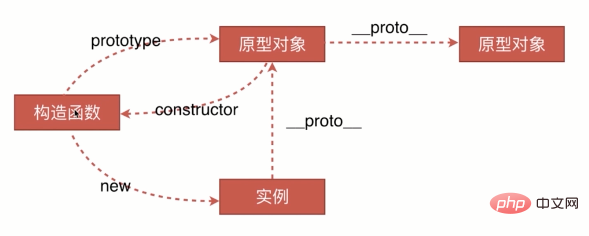|
1、this关键字 a、有对象指向对象; b、没对象指向全局变量(window); c、有new指向new出的新对象; d、bind,call&apply改变this的指向; e、setTimeout/setInterval this指向window; f、箭头函数 this 是由函数定义时候确定的; var adder = {
base : 1,
add : function(a) {
var f = v => v + this.base;
return f(a);
},
addThruCall: function inFun(a) {
var f = v => v + this.base;
var b = {
base : 2
};
return f.call(b, a);
}
};
var obj = {
i: 10,
b: () => console.log(this.i, this),
c: function() {
console.log( this.i, this)
}
}
obj.b(); // undefined window{...}原型
obj.c(); // 10 Object {...}
2、原型 prototype: prototype:每一个对象都会在其内部初始化一个属性:即prototype; 原型链:当我们访问一个对象的属性时,如果这个对象内部不存在这个属性,那么就回去
构造函数 ->prototype-> 原型对象 -> constructor -> 构造函数 构造函数 -> new -> 实例对象 实例对象 -> __proto__-> 原型对象-> __proto__->原型对象->->null 执行上下文: 变量声明与函数声明,其作用域会提升到方法体的顶部; 作用域: a、javascript没有块级作用域 b、javascript除了全局作用域之外,只有函数可以创建的作用域。作用域在函数定义时就已经确定了。而不是在函数调用时确定。 闭包: 概念: 内部函数可以访问外部函数中的变量; 使用:函数作为返回值;函数作为参数; 作用:封装变量,收敛权限; 缺点:消耗内存 创建对象的方法: 对象字面量; 构造函数; 立即执行函数; Object.create(); new 对象过程: 创建新对象; this指向这个新对象; 执行代码; 返回this; 类与继承: 类的声明: function Animal(){
this.name = 'name';
}
// es6
class Animal2{
constructor(){
this.name = 'name2';
}
}
继承: 1.借助构造函数实现继承 function Parent(){
this.name = 'parent';
}
function Child(){
Parent.call(this);
this.type = 'child1';
}
缺点: 部分继承; 继承不到父类原型对象上的方法;(只有父类的属性挂载到子类上了,Child的prototype没变为Child.prototype继承不了Parent的prototype) 2.原型链继 function Parent(){
this.name = 'name';
}
function Child(){
this.type = 'child';
}
Child.prototype = new Parent();
缺点:原型链上原型对象是共用的。(原型的属性修改,所有继承自该原型的类的属性都会一起改变) 3.组合方式 function Parent(){
this.name = 'parent';
}
function Child(){
Parent.call(this);
this.type = 'child';
}
Child.prototype = new Parent();
缺点: 父类执行函数执行两次; constructor指向父类; function Parent(){
this.name = 'parent';
}
function Child(){
Parent.call(this);
this.type = 'child';
}
Child.prototype = Parent.prototype;
缺点: 子类constructor指向父类 function Parent(){
this.name = 'parent';
}
function Child(){
Parent.call(this);
this.type = 'child';
}
Child.prototype = Object.create(Parent.prototype);
Child.prototype.constructor = Child;
优点: 子类的原型指向Object.create(Parent.prototype),实现了子类和父类构造函数的分离,但是这时子类中还是没有自己的构造函数, 所以紧接着又设置了子类的构造函数,由此实现了完美的组合继承。(也就是把父类的prototype写入子类的prototype,在定义子类的constructor) 4. es6 class Child extends Parent {
constructor(){
}
}
希望本文中的内容能够帮到学习JavaScript的同学。谢谢! 更多JavaScript的相关问题请访问PHP中文网:javascript:; (责任编辑:admin) |

